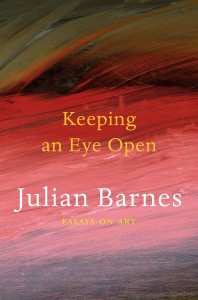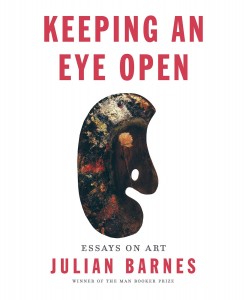 Published by Jonathan Cape UK, Knopf US
Published by Jonathan Cape UK, Knopf US
Reviewed by Siân Miles
This volume, printed and bound by the Chinese on immaculately certified acid-free paper, is initially a bit of a puzzlement. Its sumptuously produced UK cover design – front flap, spine, back, and back flap – manages to cram in largely unidentifiable bits and patches of Degas’ The Dance Lesson, Courbet’s The Artist’s Studio, Valloton’s The Lie, as well as Manet’s The Execution of Maximilian. Quite a haul in terms of space as well as permissions sought and received from globally disparate galleries and museums, attesting to the current trend in producing a book as a luxury item. There follow end-papers depicting paintbrushes and palette-knives of various shapes and sizes, should an inattentive reader miss the point. The fifty-plus illustrations are beautifully reproduced. But the key to an understanding of what it’s all about is provided by the choice of Howard Hodgkin’s multi-coloured Alpine Snow as the image on the front cover.
A personal and long-standing friend of Barnes’, Hodgkin provides the ear into which the writer’s voice, two chapters from its conclusion, ultimately confides. However, the tone for most of this collection, which is largely devoted to Barnes’ views on French painters, is uncertain, at times shaky, despite comprehensive knowledge of its subject. It offers unfunny comments allegedly à la Gardeners’ Question-Time: And whiles we’re about it, that Douanier Roussau feller’s bin plantin’ too many of them giant succulents on his patch. Including unhelpful ellipses which make do for a nudge or a wink as an ironic, cosy in-joke against, say, the Freemasons, the prose assumes a familiarity with the reader which is never properly established.
Those hoping for a collection of essays like John Berger’s Ways of Seeing will be disappointed. Others, following John Nash on Franz Hals, will find little to match his unforgettable observation that the painter captures that look which every sitter, however ugly, bestows upon the object of his affections.
A set of Essays on Art suggests the hint of an attempt to understand communication via the graphic. Instead, this volume, which considers the work of Géricault, Delacroix, Courbet, Manet, Fantin-Latour, Cézanne, Degas, Redon, Bonnard, Vuillard, Valloton, Braque, Magritte and Oldenberg, descends at times into the description of a stamp collection, with perforations and franking, rather than the meat of the message, exhaustively explored.
In its two concluding chapters, however, the reader catches a glimpse of the reason behind Barnes’ knowledgeable mystery tour d’horizon. Through his love of Hodgkin’s work and via his frank appraisal of their compatriot and contemporary Lucian Freud’s, we ultimately reach the destination of a diligent scholar’s journey from the picture to the page. Hodgkin’s Arctic Snow finally blazes out all the overtones of transmuted colour which the painter sees in whiteness and turns it into the visible piece of Glass which Barnes has all along attempted to describe.
This volume, printed and bound by the Chinese on immaculately certified acid-free paper, is initially a bit of a puzzlement. Its sumptuously produced cover design – front, front flap, spine, back, and back flap – manages to cram in largely unidentifiable bits and patches of Degas’ The Dance Lesson, Courbet’s The Artist’s Studio, Valloton’s The Lie, as well as Manet’s The Execution of Maximilian. Quite a haul in terms of space as well as permissions sought and received from globally disparate galleries and museums, attesting to the current trend in producing a book as a luxury item. There follow end-papers depicting paintbrushes and palette-knives of various shapes and sizes, should an inattentive reader miss the point. The fifty-plus illustrations are beautifully reproduced. But the key to an understanding of what it’s all about is provided by the choice of Howard Hodgkin’s multi-coloured Alpine Snow as the image on the front cover.
A personal and long-standing friend of Barnes’, Hodgkins provides the ear into which the writer’s voice, two chapters from its conclusion, ultimately confides. However, the tone for most of this collection, which is largely devoted to Barnes’ views on French painters, is uncertain, at times shaky, despite comprehensive knowledge of its subject. It offers unfunny comments allegedly à la Gardeners’Question Time: and whiles we’re about it, that Douanier Roussau feller’s bin plantin’ too many of them giant succulents on his patch. Including unhelpful ellipsis which make do for a nudge or a wink as an ironic cosy in-joke against, say, the Masons, the prose assumes a familiarity with the reader which is never properly established.
Those hoping for a collection of essays like John Berger’s Ways of Seeing will be disappointed. Others, following John Nash on Franz Hals, will find little to match his equally unforgettable observation that the painter captures that look which every sitter, however ugly, bestows upon the object of his affections.
A set of Essays on Art suggests the hint of an attempt to understand communication via the graphic. Instead, this volume which considers the work of Géricault, Delacroix, Courbet, Manet, Fantin-Latour, Cézanne, Degas, Redon, Bonnard, Vuillard, Valloton, Braque, Magritte and Oldenberg, descends at times into the description of a stamp collection, with perforations and franking, rather than the meat of the message, exhaustively explored.
In its two concluding chapters, however, the reader catches a glimpse of the reason behind Barnes’ knowledgeable mystery tour d’horizon. Through his love of Hodgkin’s work and via his frank appraisal of their compatriot and contemporary Lucian Freud’s, we ultimately reach the destination of a diligent scholar’s journey from the picture to the page. Hodgkin’s Arctic Snow finally blazes out all the overtones of transmuted colour which the painter sees in whiteness and turns it into the visible piece of Glass which Barnes has all along attempted to describe.
